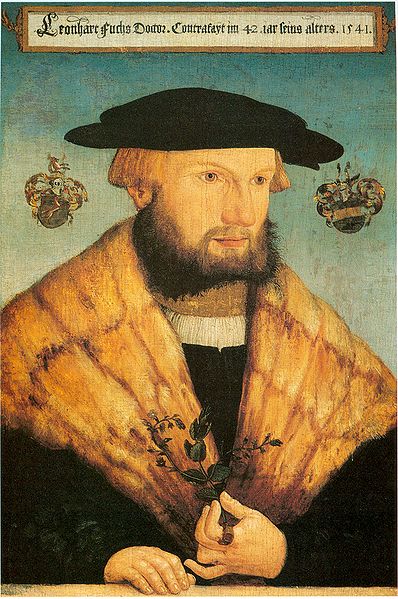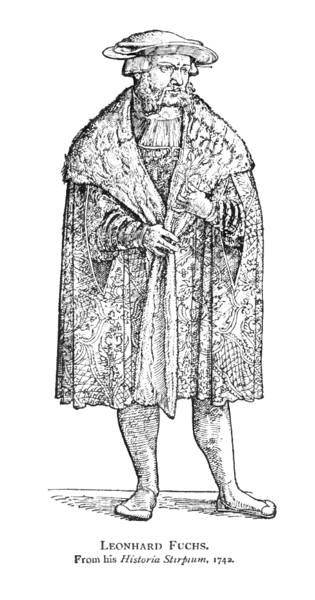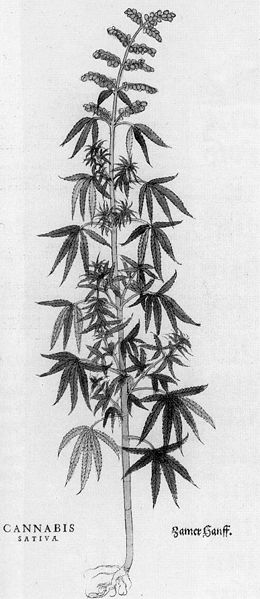<Back to Index>
- Botanist Leonhart Fuchs, 1501
- Novelist Charles Brockden Brown, 1771
- 1st President of Ireland Douglas Hyde, 1860
PAGE SPONSOR




Leonhart Fuchs (17 January 1501 – 10 May 1566), sometimes spelled Leonhard Fuchs, was a German physician and one of the three founding fathers of botany, along with Otto Brunfels and Hieronymus Bock (also called Hieronymus Tragus).
Fuchs was born in Wemding in the Duchy of Bavaria. After visiting a school in Heilbronn, Fuchs went to the Marienschule in Erfurt, Thuringia, at the age of twelve, and graduated as Baccalaureus artium. In 1524 he became Magister Artium in Ingolstadt, and was received doctor of medicine in the same year.
From 1524 - 1526 he practiced as a doctor in Munich, until he received a chair of medicine at Ingolstadt in 1526. From 1528 - 1531 he was the personal physician of Georg, Margrave of Brandenburg, in Ansbach.
Fuchs was called to Tübingen by Ulrich, Duke of Württemberg, in 1533 to help in reforming the University of Tübingen in the spirit of humanism. He created its first medicinal garden in 1535 and served as chancellor seven times, spending the last thirty-one years of his life as professor of medicine. Fuchs died in Tübingen in 1566.
Like his medieval predecessors and his contemporaries, Fuchs was heavily influenced by the three Greek and Roman writers on medicine and materia medica, Dioscorides, Hippocrates, and Galen. He wanted to fight the Arab hegemony in medicine, as it had been transmitted by the medical school of Salerno, and to "return" to the Greek authors. But he saw the importance of practical experience as well and offered botanical field days for the students, where he demonstrated the medicinal plants in situ. He founded one of the first German botanical gardens.
Fuchs' name is preserved by the plant Fuchsia, discovered on Santo Domingo in the Caribbean in 1696/97 by the French scientist Dom Charles Plumier, who published the first description of "Fuchsia triphylla, flore coccineo" in 1703. The color fuchsia is also named for him, describing the purplish-red of the shrub's flowers.
Errata recentiorum medicorum ("Errors of recent doctors") (Hagenau, 1530), is his first publication, in which he argued for the use of "simples" (herbs) rather than the noxious "compounds" of arcane ingredients concocted in medieval medicine. De historia stirpium commentarii insignes ("Notable commentaries on the history of plants", Basel, 1542), is his great herbal,
which was offered, with varying degrees of fidelity to his text, as
"New Kreüterbuch" in a German translation (1543), "New Herbal" in English, "Den nieuwen Herbarius, dat is dat boeck van den cruyden" (1543) in Dutch. Fuchs
tried to identify the plants described by the classical authors. The
book contains the description of about 400 wild and more than 100
domesticated plant species and their medical uses ("Krafft und
Würckung") in alphabetical order: Fuchs made no attempt at
presenting them in a natural system of classification. The first
reports of Zea mays and of chilli peppers were among the exotic new species The text is mainly based on Dioscorides.
The book contains 512 pictures of plants, largely growing locally, in
woodcuts. The illustrators were Heinrich Füllmauer and Albert
Meyer, the woodcutter Veit Rudolph Speckle, portraits of whom are contained in the volume. It was printed at the famous shop of Michael Isengrin in Basel.
Other notable publications include Eyn Newes hochnutzlichs Büchlin/und Anothomi eynes auffgethonen augs/auch seiner erklärung bewerten purgation/Pflaster/Tollirien/Sälblin pulvern unnd wassern/wie mans machen und brauchen sol (A new, very useful book and anatomy of the open eye/also an explanation of useful purgatives/plasters/poultices/salves, powders and waters/how one should make and use them), 1539; Alle Kranckheyt der Augen (All diseases of the eye), 1539. Fuchs's books on the anatomy of the eye and its diseases were among the standard references on this subject during this period. All in all, Leonhart Fuchs wrote more than 50 books and polemics.